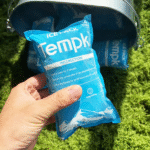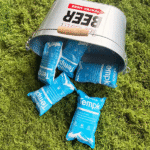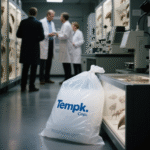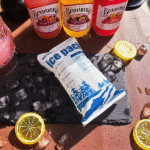Logistique de la chaîne du froid alimentaire: Navigating the 2025 Marché, Technology and Compliance
Le food cold chain logistics sector is experiencing rapid growth and transformation. Dans 2025 le marché mondial de la logistique sous chaîne du froid est estimé à USD 436.30 milliard, with projections to exceed USD 1.35 mille milliards par 2034. Meanwhile the food cold chain market alone is forecast to reach USD 65.8 milliards en 2025, grandir jusqu'à USD 205.3 milliards 2032 à un 17.5 % taux de croissance annuel composé (TCAC). These figures underscore how crucial effective cold chain management is for businesses dealing with perishable goods. As consumer expectations for freshness and transparency soar and regulations tighten, you need to understand how modern food cold chain logistics can help your company minimise waste and stay compliant.

What is food cold chain logistics and why does it matter for your business? – clarifying the key components and processes while incorporating emerging long tail keywords.
Which technologies are shaping cold chain logistics in 2025? – exploring AI, IoT, blockchain and sustainable refrigeration solutions.
How do regulations like the FSMA Rule 204 and global food laws affect cold chain operations? – highlighting compliance requirements and traceability obligations.
Where are the biggest market opportunities and growth drivers? – examining regional demand trends and sector specific insights.
What latest trends and developments should you monitor in 2025? – summarising market, technological and consumer shifts.
What Is Food Cold Chain Logistics and Why Does It Matter?
Food cold chain logistics refers to the coordinated processes, facilities and technologies used to maintain specific temperature ranges as perishable products move from farm to fork. It includes refrigerated storage, chilled and frozen transportation, insulated packaging and real time monitoring systems. The aim is to safeguard product integrity, meet quality standards and comply with regulations. Le global food cold chain market, driven by growing demand for processed and frozen foods, devrait atteindre USD 65.8 milliards en 2025 and expand to USD 205.3 milliards 2032. Such growth highlights how critical this logistics segment is for preventing spoilage and meeting consumer expectations.
Why Businesses Need Reliable Food Cold Chain Logistics
The cold chain touches every step of a product’s journey, from harvesting and pre cooling to warehousing, transport and retail delivery. Effective logistics protect you from costly food loss and ensure that goods reach customers at peak quality. Selon l'Organisation pour l'alimentation et l'agriculture, demand for processed food has increased by more than 30 % globally since 2018. Meanwhile poor temperature control contributes to an estimated 620 million metric tons of global food loss annually. In financial terms, almost one fifth of the world’s food supply is lost or wasted each year, costing roughly USD 1 billion. Strong cold chain logistics reduce this waste by maintaining proper conditions and enabling prompt corrective action.
Components and Processes of the Food Cold Chain
The cold chain is built around three core components:
Refrigerated storage – warehouses and distribution centres designed with temperature controlled zones (congelé, chilled and ambient) and pre cooling facilities. Dans 2024 the refrigerated warehouse segment alone was valued at USD 238.29 milliard.
Temperature controlled transportation – fleets of refrigerated trucks, wagons, aircraft and reefer containers. Dry ice technologies captured 55.16 % of the cold chain technology market share in 2024, highlighting the popularity of robust cooling methods. Innovative light commercial vehicles (LCVs) are gaining traction due to their efficiency and ability to navigate urban areas.
Monitoring and telemetry – Internet of Things (IoT) capteurs, data loggers and telematics platforms that provide continuous temperature and location information. Digital monitoring adoption is extensive; sur 70 % of food exporters in North America and Europe now use digital solutions to meet regulatory standards.
These elements work together to create a reliable chain. Par exemple, sensors detect temperature deviations, while automated alerts prompt corrective action, and logistics software optimises routes to reduce transit time and fuel consumption. Without this coordination, products risk spoilage and regulatory penalties.
| Food Cold Chain Components | Fonctions clés | Avantage pratique |
| Refrigerated storage | Provides temperature controlled zones (congelé, glacé, ambiant) and pre cooling facilities | Maintains product quality during warehousing and staging |
| Transport réfrigéré | Utilises insulated trucks, frigorifiques, railcars and dry ice technology | Ensures temperature stability during transit and extends shelf life |
| Surveillance & telemetry | Employs IoT sensors, data loggers and telematics platforms | Enables real time visibility, rapid response to anomalies and data driven decision making |
Astuces et conseils pratiques
Use data driven route optimisation: AI powered tools can adjust delivery routes based on traffic, weather and vehicle load to reduce transit times and maintain temperature integrity.
Implement redundant systems: Backup generators, dual refrigeration units and emergency protocols help maintain conditions during power outages or equipment failures.
Former le personnel tout au long de la chaîne: Educate employees on temperature monitoring, handling procedures and corrective actions to minimise human error.
Cas du monde réel: NewCold’s Lebanon, Indiana facility (2025) doubled its capacity with a USD 300 million investment in automation and energy efficient systems. This expansion added over 100 000 pallet positions, illustrating how large scale, automated cold storage can meet growing demand while reducing energy use and labour costs.
Which Technologies Are Shaping Cold Chain Logistics in 2025?
Technological advances are revolutionising how companies maintain temperature integrity, improve efficiency and provide transparency. Innovations such as AI powered route optimisation, blockchain traceability and solar powered refrigeration are no longer optional; they are essential for competitive advantage.
Transformation numérique: IoT, IA et Blockchain
Capteurs IoT provide continuous monitoring of temperature, humidité et emplacement. These devices enable immediate alerts when conditions deviate, reducing spoilage and compliance risks. Intelligence artificielle (IA) analyses the collected data, automating route decisions to reduce congestion and improve fleet health. AI also identifies anomalies, forecasts maintenance needs and supports decision making.
Technologie blockchain offers immutable records of product journeys, enhancing transparency and ensuring regulatory compliance. By recording every handoff and temperature reading, blockchain builds consumer trust and simplifies audits. Adoption is still emerging, but early implementations show promise in preventing fraud and improving recall efficiency.
Sustainable Refrigeration and Energy Saving Solutions
As sustainability becomes a competitive differentiator, companies are exploring eco friendly technologies. Solar powered refrigeration units offer independence from unreliable grids and reduce carbon footprints. Réfrigérants naturels (such as ammonia and CO₂) minimise environmental impact and comply with regulations phasing out high global warming refrigerants. Léger, insulated shipping containers equipped with IoT sensors enhance efficiency by monitoring temperature and humidity in real time.
Automation and Robotics in Warehousing
Systèmes automatisés de stockage et de récupération (AS/RS), robotic palletisers and AI enabled warehouse management systems reduce labour costs and improve accuracy. NewCold’s expansions in the United States incorporate highly automated facilities with double stacker cranes, automated case picking and integrated rail docks. Such automation allows facilities to handle multi customer operations efficiently and maintain consistent temperatures.
| Emerging Technology | Description | Votre avantage |
| Optimisation des itinéraires grâce à l'IA | Algorithms analyse traffic, weather and delivery windows to determine optimal routes | Cuts fuel consumption, reduces delivery time and minimises temperature deviations |
| Traçabilité de la blockchain | Records each transfer and temperature reading in an immutable ledger | Améliore la transparence, simplifies audits and strengthens customer trust |
| Réfrigération à énergie solaire | Uses photovoltaic panels to power reefer units | Provides off grid cooling and lowers energy costs |
| Conteneurs compatibles IoT | Lightweight containers with sensors monitor conditions continuously | Improves cargo integrity and reduces human monitoring efforts |
| Automation & robotique | AS/RS systems, robotic palletisers and automated case picking | Increases throughput, reduces labour requirements and maintains consistent temperatures |
Astuces et conseils pratiques
Invest in IoT sensors and analytics: Real time data allows you to make proactive adjustments and demonstrates compliance to regulators.
Plan for sustainable energy: Consider solar powered units or natural refrigerants to meet environmental targets and reduce operating costs.
Adopt automation gradually: Start with modular systems like automated pallet wrappers or conveyor belts to ease the transition to a fully automated facility.
Cas du monde réel: West Coast Cold Storage’s Jurupa Valley facility (2024) launched a 127 000 square foot refrigerated warehouse equipped with advanced warehouse management systems and electronic data interchange capabilities. The facility operates at –10 °F and has received SQF, Costco and organic certifications, showcasing how integrated technology and compliance can enhance market appeal.
How Do Regulations Shape Food Cold Chain Logistics in 2025?
Compliance is a central pillar of cold chain operations. Regulatory frameworks like the U.S. Loi sur la modernisation de la sécurité alimentaire (FSMA) and the European Union’s General Food Law demand stringent temperature control, documentation and traceability. Non compliance leads to recalls, sanctions et atteinte à la réputation.
FSMA Rule 204 and Traceability Requirements
Sous FSMA Rule 204, entities handling foods on the Food Traceability List must maintain key data elements and provide records to the U.S. Food and Drug Administration within 24 heures of a request. This rule, effective in January 2026, intensifies the need for accurate record keeping and integrated traceability systems across the cold chain.
Other U.S. regulations include the Sanitary Transportation Rule, which sets requirements for vehicle design, training and temperature control, et le Hazard Analysis and Risk Based Preventive Controls (HARPC) règle, which mandates risk assessments and preventive measures.
International Regulations: EU and Asia Pacific
Le European Union’s General Food Law (CE 178/2002) emphasises traceability and hazard prevention across the supply chain. Member states are also phasing out high global warming refrigerants such as HFCs and encouraging natural alternatives. In Asia Pacific, countries like China and India are investing heavily in cold chain infrastructure to meet export standards and consumer demands; India’s refrigerated warehouse capacity expanded by 35 % entre 2020 et 2024.
Building a Compliant Cold Chain
To meet these regulations, consider the following strategies:
Implement end to end traceability: Use digital platforms, IoT sensors and blockchain to track products from origin to consumer. Maintain easily retrievable records to satisfy 24 hour audit requirements.
Standardise processes and training: Élaborer des procédures opérationnelles standard (Sops) for handling, transportation and storage. Conducteurs de train, warehouse staff and quality assurance teams on regulatory requirements and emergency responses.
Utilise compliant equipment: Ensure that vehicles, containers and storage facilities meet design standards for insulation, ventilation and temperature control. Use calibrated thermometers and monitoring devices.
| Règlement | Exigences clés | Impact on Businesses |
| FSMA Rule 204 (NOUS.) | Maintain key data elements and provide records within 24 hours of FDA request | Requires robust traceability systems and record management |
| Sanitary Transportation Rule (NOUS.) | Vehicle design, training and temperature control standards | Mandates proper equipment, temperature monitoring and staff training |
| General Food Law (CE 178/2002) (UE) | Traceability and hazard prevention across the supply chain | Necessitates end to end documentation and risk management |
| Phasing out high GWP refrigerants | EU and global regulations encourage natural refrigerants | Drives investment in eco friendly refrigeration technologies |
Cas du monde réel: FSMA and other regulations push companies to digitise traceability. Sur 70 % of food exporters in North America and Europe now use digital monitoring solutions to meet compliance standards. Businesses that adopt digital systems gain faster recall capability and stronger consumer trust.
Where Are the Biggest Opportunities and Growth Drivers?
The food cold chain logistics market is not monolithic. Understanding regional dynamics and sector specific drivers helps you focus investments and partnerships.
Amérique du Nord: Mature Markets and Consolidated Players
The North American cold chain market is booming. Les États-Unis. cold chain logistics market is valued at USD 91 milliards en 2025 et devrait atteindre USD 109 milliards 2030. Canada’s market will grow from USD 6 milliards en USD 7 milliard, while Mexico’s market will rise from USD 7 milliards en USD 8 milliard during the same period. Collectively these markets could exceed USD 124 milliard par 2030. Industry leaders such as Lineage Logistics (2.1 billion cubic feet of storage) and Americold (1.3 billion cubic feet) control over 50 % des États-Unis. cold storage capacity, giving them scale efficiencies and bargaining power.
Asie-Pacifique: Rapid Expansion and E Commerce Boom
L’Asie-Pacifique est la région à la croissance la plus rapide, with a cold chain logistics market expected to grow from USD 168.24 milliards en USD 253.92 milliard par 2030 à un TCAC de 8.58 %. The chilled segment commands roughly 68 % du marché, reflecting consumer preference for fresh foods. The APAC food e commerce market (including fresh and frozen items) is projected to hit USD 635.44 milliards 2029. Rising incomes, urbanisation and increasing demand for premium dairy, seafood and meat drive this expansion.
Europe: Sustainability and Regulatory Leadership
Europe is emphasising sustainable refrigeration and strict food safety standards. Investments in natural refrigerants and renewable energy are increasing. European companies are also deploying blockchain and IoT solutions for traceability to meet FSMA comparable requirements. Retailers and logistics providers collaborate to reduce emissions and report Scope 3 emissions as part of corporate sustainability reporting.
Emerging Markets and Sector Drivers
Other factors shaping demand include:
Pharmaceutical and biotech growth: The pharmaceutical cold chain market is projected to reach USD 9.3 milliards 2034. Biologics and vaccines require ultra cold storage and specialised transportation, spurring investment in advanced cold chain infrastructure.
E grocery and convenience: Online grocery penetration is expected to exceed 20 % of global grocery sales by 2030. Consumers demand fast delivery, prompting retailers to expand micro fulfilment centres and last mile refrigeration.
Plant based foods and new proteins: Plant based meats and alternative proteins could represent 7.7 % du marché mondial des protéines par 2030. These products require cold storage to preserve taste and texture.
Quick service restaurants (QSRs): En Inde, the QSR sector is projected to grow 20 %–25 % au cours de l'exercice 2024, driving demand for reliable cold chain infrastructure.
Cross border trade: Lower trade barriers and programmes like the UK Dairy Export Programme have increased exports of perishables. Social media exposure to new cuisines also boosts demand for imported products.
| Region or Sector | Market Size & S'orienter | Business Implication |
| Amérique du Nord | NOUS. market grows from USD 91 B to USD 109 B par 2030; Canada and Mexico also expand | Mature market with consolidated players and high regulatory compliance |
| Asie-Pacifique | Market grows from USD 168.24 B to USD 253.92 B par 2030, chilled segment 68 % | Rapid growth driven by e commerce, rising incomes and urbanisation |
| Europe | Focus on sustainability and natural refrigerants | Opportunities in eco friendly solutions and compliance consulting |
| Médicaments | Cold chain pharma market projected at USD 9.3 B par 2034 | Requires ultra cold facilities and stringent monitoring |
| E grocery & QSR | Online grocery penetration >20 % par 2030; QSR growth 20–25 % | Expands demand for last mile delivery and micro fulfilment centres |
| Plant based & New proteins | Could reach 7.7 % of global protein market by 2030 | Needs temperature control to preserve texture and quality |
Astuces et conseils pratiques
Evaluate regional partnerships: Collaborate with local providers in growth regions like Asia Pacific to leverage existing networks and regulatory knowledge.
Invest in sector specific capabilities: Pour les produits pharmaceutiques, prioritise ultra low temperature storage and validated transport containers. For e grocery, focus on micro fulfilment and last mile solutions.
Monitor consumer trends: Demand for plant based products and premium dairy requires flexible storage zones (réfrigéré et congelé) and transparent labelling.
Cas du monde réel: NewCold’s expansion in Hagerstown, Maryland (opening in 2027) will offer a multi customer automated facility with advanced case picking and rail connectivity. Such investments illustrate how providers respond to regional demand while integrating automation and sustainability.
2025 Derniers développements et tendances
Aperçu de la tendance
The landscape of food cold chain logistics is evolving rapidly. Les principales tendances comprennent:
Standardisation and interoperability: Environ 74 % of logistics data is expected to be standardised by 2025, enabling seamless data exchange across systems and stakeholders.
Advanced visibility and predictive analytics: AI and predictive analytics tools are becoming common, offering end to end visibility and proactively identifying risks, such as temperature deviations and equipment failures.
Sustainability and eco friendly solutions: Companies are investing in natural refrigerants, renewable energy and lightweight packaging to reduce carbon footprints. Solar powered refrigeration and electric reefer trucks are gaining traction.
Last mile and e commerce innovation: The surge in e grocery and fast delivery has led to the rise of micro fulfilment centres and refrigerated light commercial vehicles, which are more agile and cost effective.
Fusions et acquisitions (M.&UN): Consolidation among major cold chain providers continues, with large players like Lineage and Americold expanding capacity and acquiring regional firms. New entrants are also investing aggressively, as seen with RLS Logistics and CJ Logistics.
Transparency and consumer demand: Consumers increasingly demand supply chain transparency, with surveys reporting that 99 % of consumers value transparency and 75 % would switch brands for more detailed supply chain information.
Aperçu des derniers progrès
Expansion du marché: The global cold chain logistics market size is USD 436.30 milliards en 2025, projeté d'atteindre USD 1.35 mille milliards par 2034.
Industry concentration: Lineage and Americold collectively control over 50 % des États-Unis. cold storage capacity, driving M&A and investment strategies.
Investment in sustainability: Companies like Eja Ice Nigeria are adopting solar powered refrigeration units to improve food security.
Regulatory timelines: FSMA Rule 204 compliance deadlines approach in 2026, prompting companies to integrate digital traceability systems.
APAC growth: The APAC cold chain logistics market is predicted to reach USD 253.92 milliards 2030, while online grocery is set to hit USD 635.44 milliards 2029.
Insistance au marché
In addition to high growth rates, market insights reveal that North America commands 32 % of the global food cold chain market share. The frozen segment accounts for 59.7 % of market volume in 2025, reflecting consumer preference for frozen meals and seafood. Investments exceeding USD 5 milliard have been announced by leading cold chain companies between 2023 et 2025 to expand automation and green refrigeration. These insights indicate that businesses must prioritise both capacity expansion and sustainability to remain competitive.
Questions fréquemment posées
Question 1: How does food cold chain logistics reduce food waste?
Effective food cold chain logistics maintains proper temperatures from harvest to consumption. By using refrigerated storage, insulated transport and continuous monitoring, companies minimise spoilage, which currently accounts for almost one fifth of global food production. Adopting digital tracking ensures timely interventions and supports sustainability goals.
Question 2: What technologies are essential for cold chain compliance?
Capteurs IoT, AI analytics and blockchain are core technologies. Sensors provide real time temperature data, AI optimises routes and predicts maintenance, while blockchain creates immutable records for audits. Together they facilitate compliance with FSMA Rule 204 et autres réglementations.
Question 3: How can small and medium sized enterprises (SMEs) implement cold chain logistics effectively?
SMEs can partner with third party logistics providers that offer shared refrigerated warehouses and transport. Leveraging rental LCVs and cloud based monitoring platforms reduces upfront costs. Investing in insulated packaging and training staff also helps protect products during transit.
Question 4: What is the significance of natural refrigerants?
Natural refrigerants such as ammonia and CO₂ have low global warming potential, making them compliant with regulations phasing out high GWP refrigerants. They offer efficient cooling and help companies meet sustainability targets while avoiding future regulatory penalties.
Question 5: Why is the Asia Pacific region so important for cold chain logistics?
APAC’s rapid urbanisation, rising incomes and booming e commerce drive demand for chilled and frozen foods. The regional cold chain market is expected to grow from USD 168.24 milliards en USD 253.92 milliards 2030, with the chilled segment dominating 68 %. Businesses tapping into APAC can capitalise on this growth by investing in local partnerships and last mile solutions.
Résumé et recommandations
Principaux à retenir
Le global marché de la logistique de la chaîne du froid is experiencing robust growth, with the food segment alone expected to reach USD 205.3 milliards 2032 and the overall logistics market to exceed USD 1.35 mille milliards par 2034. Businesses must scale capacity and adopt technology to remain competitive.
Emerging technologies—IoT sensors, Analyse de l'IA, blockchain and automation—are transforming the industry by enhancing transparency, efficacité et conformité.
Regulations like FSMA Rule 204 et le European General Food Law demand comprehensive traceability and rapid data retrieval. Companies should implement digital record systems and train staff accordingly.
Market opportunities vary by region. North America offers scale and consolidation, Asia Pacific presents rapid growth and e commerce opportunities, and Europe leads in sustainable solutions.
Consumer expectations for transparency and sustainability drive investments in eco friendly refrigeration, renewable energy and digital traceability, while consolidation and new entrants shape competitive dynamics.
Plan d'action
Conduct a cold chain audit: Assess your current equipment, processes and data systems. Identify gaps in temperature control, traçabilité et conformité.
Adopt core technologies: Implement IoT sensors for real time monitoring, AI powered route optimisation and blockchain for traceability. Select modular solutions that can scale as your volumes grow.
Enhance sustainability: Replace high GWP refrigerants with natural alternatives and invest in renewable energy solutions like solar powered refrigeration. Adopt lightweight, recyclable packaging to reduce waste.
Strengthen partnerships: Collaborate with regional logistics providers to access networks in high growth markets. Explore co investment opportunities in automation and cold storage expansions.
Plan for regulatory deadlines: Prepare for the FSMA Rule 204 deadline by documenting procedures and integrating digital record keeping. Review international regulations if you operate globally.
À propos du tempk
Tempk is a forward thinking company specialising in advanced cold chain solutions. We develop insulated packaging, temperature controlled containers and IoT enabled monitoring systems that help businesses maintain product quality from origin to destination. Our systems leverage real time data, natural refrigerants and AI algorithms to optimise routes and reduce energy consumption. By focusing on compliance and sustainability, nous accompagnons nos clients dans le domaine alimentaire, pharmaceutical and biotech sectors to minimise waste and meet the evolving regulatory landscape.
Prêt à améliorer votre chaîne du froid? Contact Tempk today for expert consultation and discover how our solutions can reduce your product loss, enhance regulatory compliance and unlock new market opportunities.























